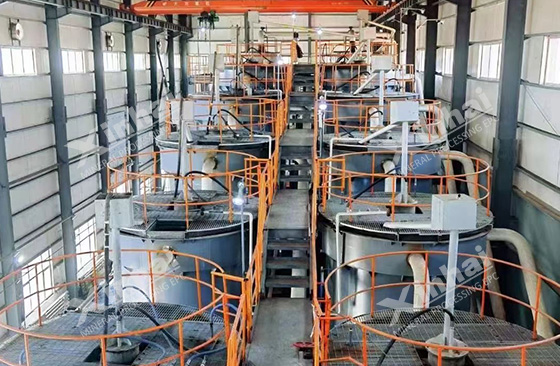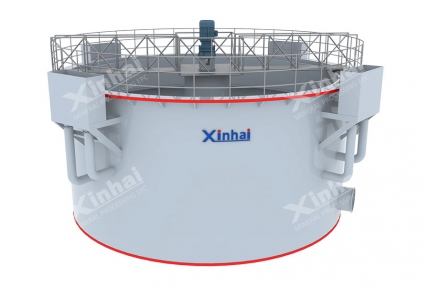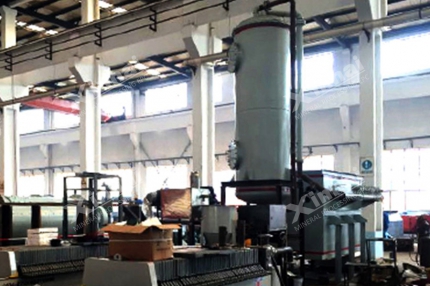Arsenic is a mineral element that widely exists in the earth's crust. However, the presence of arsenic is almost always regarded as a harmful substance, affecting the selection of other useful minerals. Especially gold ores contain arsenic. When the arsenic content reaches more than 0.1%, it is called It is an arsenic-containing gold ore, which is a typical refractory gold ore.
In order to effectively obtain gold minerals, effective arsenic removal is key. So what are the arsenic-containing gold ores? Currently, the available technologies for removing arsenic from gold mines and extracting gold include: flotation method, oxidation roasting-cyanide leaching method, bacterial oxidation-cyanide leaching method, non-cyanide leaching method, etc. Let’s find out together!
Use the table of contents below to navigate through the guide:
01Flotation process for extracting gold and removing arsenic
The flotation method separates arsenic-containing gold ores, mainly targeting gold minerals that do not use arsenic sulfide as a carrier. The gold-containing sulfide ores are separated from arsenopyrite through flotation. The key to high flotation efficiency is the high efficiency of gold. Selection of collectors and effective inhibitors of arsenic. Currently available gold collectors include mercapto anions, thioesters and amino acids; arsenic inhibitors include lime combination inhibitors, strong oxidation inhibitors, carbonate inhibitors, and sulfur oxygen compound inhibitors. and organic inhibitors, etc.

02Oxidation roasting-cyanide leaching for extracting gold and removing arsenic
The roasting oxidation-cyanidation leaching gold extraction process is to roast arsenic gold ore under high temperature conditions. With the help of air or oxygen, the arsenic sulfide coating the gold is oxidized and decomposed, and the wrapped gold can be exposed. Subsequent processing Gold is cyanide leached to improve gold recovery. There are three methods of gold roasting: traditional roasting, arsenic solid roasting and two-stage roasting.
Traditional roasting for extracting gold: The traditional rotary kiln roasting and oxidation method is used. Under suitable process conditions, roasted sand with an arsenic content of only 0.109% can be obtained, and the arsenic volatilization rate reaches 98.85%. This process will produce a large amount of toxic gases such as SO2 and As2O3 during the roasting process, which will damage the surrounding environment. Dust collection and purification equipment is required, but the cost is high.
Arsenic-fixing roasting for extracting gold: This method, also known as alkali-added roasting, is an improvement on the traditional roasting process. It not only retains the advantages of traditional roasting, but at the same time, the addition of alkali can effectively fix harmful impurities such as sulfur and arsenic. In the baking sand (rather than evaporating in the form of smoke), it effectively avoids environmental pollution.

Two-stage roasting for extracting gold: During the roasting process, the composition of the atmosphere affects the oxidation of arsenic minerals to a certain extent. If the oxygen is insufficient, the arsenic in the gold ore will volatilize in the form of As2O3; if the oxygen is sufficient, the arsenic in the gold ore will volatilize in the form of As2O5. Form exists, and As2O5 can react with alkaline oxides to form difficult-to-volatile arsenate that remains in the calcined sand. If only one stage of roasting is used to treat gold concentrate with high arsenic content, the roasting temperature and oxygen amount are difficult to control, and "under-burning" or "over-burning" often occurs. Two-stage roasting can effectively solve this problem. Among them, one section uses a neutral or weak oxidizing atmosphere to remove arsenic at a temperature of 400 to 600℃; the second section uses an oxidizing atmosphere to remove arsenic at a temperature of 600 to 800℃. This can not only solve the problem of desulfurization and dearsenization well. In order to solve the problem, the As2O3 produced during roasting can also be converted into powdery white arsenic products, which does not pollute the environment and can achieve the purpose of comprehensive utilization.

03Bacterial oxidation-cyanidation leaching for extracting gold and removing arsenic
Bacterial oxidation of sulfide is a multi-phase, bacterial-catalyzed oxidation process that occurs at the mineral interface. Through the oxidation of sulfide by bacteria, the minerals are desulfurized and arsenicized, and the crystals are destroyed, exposing the (ultra)fine particles of gold wrapped in them, which is beneficial to subsequent cyanide gold leaching.
Commonly used bacterial species for bacterial oxidative pretreatment include Thiobacillus ferrooxidans, Thiobacillus thiooxidans, and Microspirillum ferrooxidans. The chemical mechanism of bacterial leaching mainly includes three bacterial direct action mechanisms, indirect action mechanisms, and compound action mechanisms.
In the process of bacterial oxidation, arsenopyrite in arsenic gold ores is easily oxidized and decomposed, while realgar cannot be oxidized and decomposed by bacteria and will affect the activity of bacteria; in the process of cyanide leaching, arsenopyrite is very stable and does not occur Any side reaction, while realgar will consume cyanide and protective alkali, and the precipitate generated by the reaction will form a thin film on the surface of gold particles, hindering the cyanide reaction of gold. Therefore, during the flotation enrichment operation of arsenic-containing gold ores, realgar should be suppressed as much as possible.

04Non-cyanide leaching method for extracting gold and removing arsenic
For arsenic-containing refractory gold ores, the existing non-cyanide leaching process research mainly focuses on the leaching of thiosulfate and thiocyanate.
Thiosulfate leaching: An ammoniacal thiosulfate solution is used for leaching. This solution can effectively dissolve orpiment, realgar and other arsenic-containing minerals coating the surface of gold particles, and the gold can be effectively leached.
Thiocyanate leaching: It is a halide-like compound containing -SCN. Compared with cyanide, it has the advantages of stable properties, low toxicity and low price.

The above is an introduction to the process of removing arsenic and extracting gold from arsenic-containing gold ores. In the actual gold extraction process, each type of gold ore contains different arsenic characteristics and arsenic content, so the arsenic removal process used to extract gold is also different. Similarly, it is recommended to conduct analysis first and design a suitable gold extraction process plan for arsenic-containing gold ores. At the same time, the complete set can also be scheduled according to the process plan.


 marketing@ytxinhai.com
marketing@ytxinhai.com  0086 13810327080
0086 13810327080 






































































































 CHAT
CHAT MESSAGE
MESSAGE







